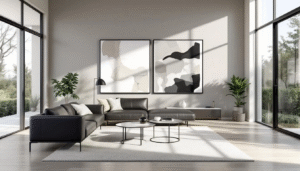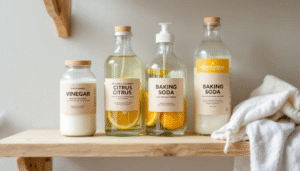When you decide to sell your home, you are no longer just a homeowner; you are a marketer of a high-value product. The goal is to sell that product faster and for the highest possible price. In the competitive Naples real estate market, achieving that goal depends on one critical factor: the first impression. A “showcase-ready” home doesn’t just happen; it’s the result of a strategic process designed to captivate potential buyers from the moment they see the online listing to the second they walk through your front door.
This isn’t just about tidying up. This is about transforming your lived-in home back into a desirable product. It’s a blend of deep cleaning, decluttering, depersonalizing, and strategic staging. While it requires effort, the return on investment is undeniable. This comprehensive guide will provide you with an actionable, evidence-based plan to make your home truly showcase-ready, helping you secure the best possible outcome in your sale.
Why a “Showcase-Ready” Home Sells Faster and For More
Before diving into the checklist, it’s essential to understand the “why.” The effort you put in now translates directly into tangible financial results.
The Psychology of a Buyer’s First Impression
You only get one chance to make a first impression. A study from the Association for Psychological Science found that first impressions can last for months, powerfully shaping judgment even when conflicting evidence is presented later. For real estate, this means a buyer’s initial feeling upon entering your home sets the tone for their entire visit.
A clean, bright, and depersonalized home allows buyers to do the most important thing they need to do: visualize themselves living there. When they see personal photos, clutter, and specific decor, they feel like guests in someone else’s house. When they see a clean, neutral canvas, they can begin to mentally place their own furniture and imagine their own life unfolding within the walls. According to the National Association of REALTORS® (NAR), a staggering 83% of buyers’ agents agree that staging a home makes it easier for a buyer to see it as their future home.
The Financial ROI of Preparation: What the Statistics Say
The benefits are not just psychological; they are financial. Investing in preparing your home is one of the highest-ROI activities in the selling process.
Higher Sale Price: NAR’s 2023 Profile of Home Staging found that 19% of sellers’ agents saw an increase of 6-10% in the dollar value offered by buyers for a staged home compared to similar unstaged homes. Another 19% saw an increase of 1-5%. On a $750,000 home, that’s a potential increase of $7,500 to $75,000.
Faster Sale: Time is money. The International Association of Home Staging Professionals (IAHSP) found that homes staged prior to listing spent an average of just 23 days on the market, compared to 184 days for homes that were not staged.
Reduced Price Reductions: A home that is pristine from day one is less likely to languish on the market and require a price cut. The Real Estate Staging Association (RESA) reports that professionally staged homes are significantly less likely to need a price reduction.

The 4 Pillars of a Showcase-Ready Home: A Comprehensive Checklist
Achieving a showcase-ready state involves a systematic approach. We’ve broken it down into four foundational pillars.
For your convenience, you can print our home staging checklist PDF to keep track of your progress as you work through each pillar.
Pillar 1: The Foundational Deep Clean
A truly deep clean is the non-negotiable first step. It signals to buyers that the home has been meticulously maintained.
Kitchen (The Highest Impact Zone):
Appliances: Clean the inside and outside of the refrigerator, oven, microwave, and dishwasher. Remove all grease from stovetops and polish stainless steel surfaces.
Cabinets & Drawers: Wipe down all cabinet doors, handles, and pulls. Organize the inside of drawers and cabinets, as buyers will look inside to gauge storage.
Countertops & Backsplash: Scrub all surfaces to remove stains, crumbs, and smudges.
Sink & Faucet: Remove all hard water stains and polish the sink and fixtures until they gleam.
Bathrooms (The Spa Sanctuary):
Grout & Tile: Scrub all tile and grout lines in the shower and on the floor until they are their original color.
Glass & Mirrors: Ensure shower glass is free of all soap scum and that mirrors are streak-free.
Fixtures: Polish faucets, showerheads, and handles to a high shine.
Toilets & Sinks: Clean and disinfect every surface, including the base of the toilet.
General Living Areas & Bedrooms:
Dust Everything: Dust all surfaces from top to bottom, including ceiling fans, light fixtures, shelves, and coffee tables.
Windows & Curtains: Clean all window panes, sills, and tracks for maximum natural light. Launder or dust all window coverings.
Walls & Baseboards: Wipe down walls to remove scuffs and clean all baseboards to create a crisp, finished look.
Floors:
Deep clean all carpets to remove stains and odors. Consider a professional steam cleaning.
Mop and polish all hardwood and tile floors.
Pillar 2: Decluttering and Depersonalizing for a Blank Canvas
Your goal is to make the home feel spacious, organized, and anonymous.
Remove Personal Photos: This is the most important step. Take down all family photos from walls, mantles, and refrigerators. Replace them with neutral art.
Pack Away Collections & Memorabilia: Box up collectibles, memorabilia (including sports team items), and any religious articles. The goal is to appeal to the widest possible audience.
Clear All Surfaces: Countertops, nightstands, and shelves should be mostly clear. “Less is more,” advises Investopedia. A single vase of fresh flowers is better than a dozen knickknacks.
Organize Closets & Storage: Buyers love storage space. Don’t hide clutter in closets. Organize them neatly and leave them about 30-40% empty to give the impression of ample space.
Hide All Signs of Pets: Not all buyers are pet lovers. Remove food bowls, pet beds, toys, and litter boxes before any showing.
Pillar 3: Strategic Staging and Repairs
Staging isn’t about hiding flaws; it’s about highlighting features.
Define Each Room: Ensure every room has a clear, single purpose. A “junk room” should be staged as a guest bedroom or home office to show its potential.
Furniture Arrangement: Arrange furniture to maximize the feeling of space and create clear walking paths. Pull furniture away from the walls to make rooms feel larger.
Minor Repairs: Fix the “little things” that give a bad impression. According to the National Association of REALTORS®, “Sticky doors, torn screens, cracked caulking, or a dripping faucet may seem trivial, but they’ll give buyers the impression that the house isn’t well-maintained.”
Neutralize Your Palette: If you have bold accent walls, consider repainting them with a soft, neutral “greige” or off-white. This helps buyers visualize their own decor.
Add Layers and Texture: To avoid a sterile look, add warmth back in with neutral elements like a cozy throw blanket on the sofa, new accent pillows, or a tasteful area rug.
Pillar 4: Creating Curb Appeal and an Inviting Entry
The first impression happens before a buyer even enters the home.
Landscaping: Mow the lawn, edge the walkways, and trim overgrown bushes and trees.
Add Fresh Mulch: A fresh layer of dark brown or black mulch in all flower beds provides instant contrast and makes the entire yard look well-kept.
Plant Colorful Flowers: Add a pot of bright, seasonal flowers near the entryway for a welcoming pop of color.
Front Door: Ensure the front door is clean and inviting. Consider a fresh coat of paint if needed, and polish the hardware.
Lighting: Clean all exterior light fixtures and replace any burnt-out bulbs.
Room-by-Room Perfection: Tailoring Your Home’s Appeal
To truly captivate potential buyers, it’s essential to go beyond general cleaning and decluttering—each room in your house deserves its own spotlight. A comprehensive home staging checklist will help you systematically transform every space, ensuring your home feels inviting, functional, and move-in ready. By tailoring your approach to each area, you’ll highlight your home’s best features and create a welcoming atmosphere that resonates with buyers. Use these tips and your staging checklist to make every room a place buyers can imagine themselves living in, increasing your home’s appeal and selling potential.
Kitchen: The Heart of the Home
The kitchen is often the centerpiece of any home, and it’s one of the first places potential buyers will scrutinize. To make your kitchen stand out, start by using your home staging checklist to declutter countertops, remove small appliances, and clear out unnecessary items from cabinets and drawers. Focus on creating a sense of space and cleanliness—polished surfaces, organized shelves, and a neutral color palette can make a world of difference. If you’re unsure how to best stage your kitchen, consider hiring a professional stager for expert guidance on highlighting unique features like updated appliances or a spacious island. Remember, a well-staged kitchen not only looks inviting but also helps buyers envision themselves cooking, entertaining, and making memories in the space. Don’t forget to add a few tasteful touches, such as a bowl of fresh fruit or a stylish vase, to complete the look and make your kitchen truly shine.
Bathrooms: Spa-Like Serenity
Bathrooms are a key selling point, and transforming them into spa-like retreats can leave a lasting impression on potential buyers. Start by thoroughly decluttering and cleaning every surface, from countertops to shower doors. Use your home staging checklist to ensure you’ve addressed every detail, such as neatly folded towels, sparkling fixtures, and organized toiletries. To create a sense of serenity, add calming decorative items like a small plant, a tray with luxury soaps, or a plush bath mat. If you want to take your bathroom staging to the next level, a professional stager can offer tips on color schemes and accessories that evoke relaxation and comfort. By focusing on these details, you’ll transform your bathrooms into inviting spaces that help buyers imagine unwinding after a long day—an emotional connection that can make your home stand out.
Bedrooms: Restful Retreats
Bedrooms should evoke a sense of peace and relaxation, allowing potential buyers to picture themselves unwinding at the end of the day. Use your home staging checklist to guide you through decluttering nightstands, removing personal items, and minimizing decor for a clean, serene look. Opt for soft, neutral bedding and simple accessories to create a calming atmosphere. Pay attention to lighting—open curtains to let in natural light and add bedside lamps for a cozy glow. Remember, the goal is to make each bedroom feel like a restful retreat, free from distractions and clutter. By staging your bedrooms thoughtfully, you’ll help buyers see the space as their own private sanctuary, increasing your home’s appeal and selling potential.
Living Areas: Inviting and Versatile Spaces
Living areas are where buyers imagine gathering with family and friends, so it’s crucial to stage these spaces to feel both inviting and versatile. Start by using your home staging checklist to declutter surfaces, arrange furniture to maximize flow, and remove any overly personal or bold decor. Consider the lifestyle of your potential buyers—whether it’s a cozy reading nook, a space for entertaining, or a family-friendly layout, tailor the room to showcase its flexibility. Add a few well-chosen items, such as a stylish throw, decorative pillows, or a tasteful centerpiece, to create warmth and visual interest. By staging your living areas with care, you’ll help buyers envision their own lifestyle in the space, making your home more memorable and desirable.
The Day of the Showing: Your Final Walkthrough Checklist
In the 30-60 minutes before a showing, run through this final checklist.
Turn on All the Lights: Even during the day, turn on every lamp and overhead light. This makes the home feel bright, cheerful, and welcoming.
Open All Blinds and Curtains: Maximize natural light and show off the views.
Set a Comfortable Temperature: Generally, 70-75°F is a comfortable temperature for heating or air conditioning.
Check for Odors: Take out all trash. Run a lemon rind through the garbage disposal. Avoid cooking strong-smelling foods. The goal is a neutral, fresh scent.
Final Wipe-Down: Quickly wipe down kitchen counters and bathroom sinks.
Close Toilet Lids.
Make all Beds.
Vacate the Property: It’s critical that you (and your pets) are not home during the showing. Buyers feel more comfortable and will spend more time exploring when the homeowner is not present.
FAQ: Preparing Your Home for Showings
Q1: What is the most important room to focus on when preparing for a showing? According to NAR data, the living room is the most important room to stage for buyers (37%), closely followed by the primary bedroom (34%) and the kitchen (23%). These three areas are where buyers make their strongest emotional connections.
Q2: Should I hide all evidence that I have pets? Yes, as much as possible. While you love your pets, a potential buyer may have allergies or may not be a pet person. It’s crucial to remove food and water bowls, pet beds, toys, and litter boxes before each showing. A deep clean to remove pet hair and odors is also essential.
Q3: Is it better to show an empty house or a staged house? While some sellers think an empty house allows buyers to “envision their own furniture,” data overwhelmingly shows the opposite is true. Most buyers have difficulty visualizing the potential of an empty space. Staging helps define the space, showcase its scale, and create an emotional connection.
Q4: What are the biggest mistakes sellers make? The most common mistakes are overpricing the home, failing to deep clean and declutter, using poor-quality listing photos, and being present during showings. Each of these can deter qualified buyers and lead to a longer time on market.
Q5: How much does professional staging really cost? Costs vary widely, but HomeAdvisor data shows an average between $837 and $2,924. A simple consultation may be $150-$600, while furnishing an empty home can be $500-$600 per room per month. However, given the potential 5-15% return on investment, the cost is often recouped multiple times over in the final sale price.




